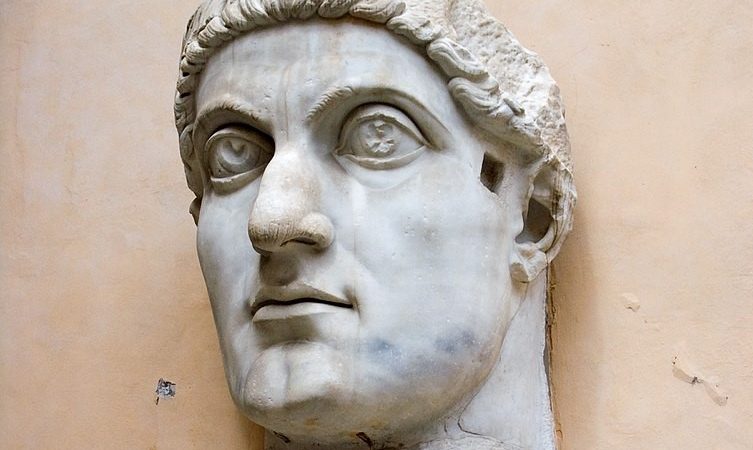Constantine was the first emperor to stop the persecution of Christians and to legalize Christianity...
Hesham Shehab: Did the Constantinian Roman Empire Divert the Christian Mission?

Did the Constantinian Roman Empire Divert the Christian Mission?
Even though the persecution of Christians occurred, sporadically and usually locally, throughout the Roman Empire, in the first three centuries, the faith spread through preaching and mercy works.
Originally a polytheistic empire in the traditions of Roman paganism and the Hellenistic religion, as Christianity spread through the empire, it came into ideological conflict with the imperial cult of ancient Rome. Pagan practices such as making sacrifices to the deified emperors or other gods were abhorrent to Christians as their beliefs prohibited idolatry. The state and other members of civic society punished Christians for treason, various rumored crimes, illegal assembly, and for introducing an alien cult that led to Roman apostasy.
Constantine, the First “Christian” Emperor!
Constantine was the first emperor to stop the persecution of Christians and to legalize Christianity, along with all other religions/cults in the Roman Empire. In February 313, he developed the Edict of Milan, which stated that Christians should be allowed to follow their faith without oppression. This removed penalties for professing Christianity, under which many had been martyred previously, and it returned confiscated Church property. The edict protected all religions from persecution, not only Christianity, allowing anyone to worship any deity that they chose. The Edict of Milan included several clauses which stated that all confiscated churches would be returned, as well as other provisions for previously persecuted Christians. Scholars debate whether Constantine adopted his mother Helena’s Christianity in his youth, or whether he adopted it gradually over the course of his life.
According to Christian writers, Constantine was over 40 when he finally declared himself a Christian. Despite these declarations of being a Christian, he waited to be baptized on his deathbed, believing that the baptism would release him of any sins he committed in the course of carrying out his policies while emperor. He supported the Church financially, built basilicas, granted privileges to clergy (such as exemption from certain taxes), promoted Christians to high office, and returned property confiscated during the long period of persecution. His most famous building projects include the Church of the Holy Sepulcher and Old Saint Peter’s Basilica.
In 321, he legislated that the venerable Sunday should be a day of rest for all citizens. After the pagan gods had disappeared from his coinage, Christian symbols appeared as Constantine’s attributes, the chi rho between his hands or on his labarum, as well on the coin itself.
The reign of Constantine established a precedent for the emperor to have great influence and authority in the early Christian councils, most notably the dispute over Arianism. Constantine disliked the risks to societal stability that religious disputes and controversies brought with them, preferring to establish an orthodoxy. His influence over the Church councils was to enforce doctrine, root out heresy, and uphold ecclesiastical unity; the Church’s role was to determine proper worship, doctrines, and dogma.
Constantine made some new laws regarding the Jews; some of them were unfavorable towards Jews, although they were not harsher than those of his predecessors. It was made illegal for Jews to seek converts or to attack other Jews who had converted to Christianity. They were forbidden to own Christian slaves or to circumcise their slaves.
Did the State Kill the Mission?
With the benefits lavished on Christians in the Roman Empire, undoubtedly the nature of conversion changed. This is particularly evident in the decrease of kerygmatic proclamation, thorough catechesis, and the universal practice of infant baptism. After the sixth century, when all the inhabitants of a society were baptized, mission largely disappeared from Western Christendom. Also, did monarchs such as Justinian and Charlemagne replace the church as the agents of mission? Since Paganism persisted within the Roman Empire, the expansion scope of Christendom was not quite as comprehensive as some historians may claim. Much of the conversion of Pagans to Christianity in this period occurred largely as it had prior to Constantine—through Pagans observing miracles and hearing Christian preaching.
Conclusion
Finally, it would be profitable to consider some of the ambiguous narrative of Christian expansion within the Christendom paradigm. That is, there are clear accounts of bishops and missionaries who had access to the power and privilege of Christendom but who approached their ministry in a more missional manner.
This raises a couple of important questions for further study for evangelicals contemplating mission today. First, for modern evangelicals, reflecting on this period of church history can be troubling as it challenges some of our deep presuppositions about the nature of the church, the state, and how the Gospel spreads. Should we be disturbed by accounts of political leaders being converted or even national conversions? Perhaps this historical reflection will challenge us to read with fresh eyes the Old Testament canonical book of Jonah in which a king’s conversion and a nation’s repentance figure prominently. (Jonah 3:6-10 ESV)
Second, this raises the critical question, is imperial Christianity incompatible with a biblical theology of mission?
Even though a number of missionaries in this period seemed to co-exist with and work within the Christendom paradigm, there are certainly some non-negotiable distinctives of authentic mission.
First, the agent of Christian mission is always the church and never the state. Second, the activities of mission must include kerygmatic proclamation and the related ministries of teaching, baptism, establishing churches, and caring for real human needs. These values seem evident in the ministry of Basil (died in 379 A.D.)—a bishop who preached, taught, baptized, and cared for the poor under the administration of an Arian emperor who clearly fell outside the bounds of Christian orthodoxy. On the contrary, the violent and coercive actions of Charlemagne toward the Saxons cannot be deemed as missional.
In summary, as Scripture is read with a hermeneutic of mission, there is also much value in reading and evaluating Christian mission history. While this article has certainly revealed the messiness of Christian and missions history, it has also shown that the essence and activities of mission have endured in a Christendom and now post-Christendom period.
Read more from Hesham Shehab… https://xpian.news/?s=hesham&submit=Search…

Hesham Shehab
Adjunct Faculty at College of DuPage, Formerly Adjunct Faculty at American University of Beirut and Pastor at Peace Lutheran Church Lombard, IL Name pronounciation: HI-shahm SHI-hab Hebrews 12: 4 & Philippians 1: 29




Comments are Closed